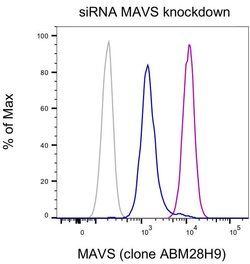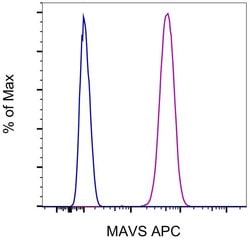Learn More
MAVS Monoclonal Antibody (ABM28H9), APC, eBioscience™, Invitrogen™
Mouse Monoclonal Antibody
$493.00
Specifications
| Antigen | MAVS |
|---|---|
| Clone | ABM28H9 |
| Concentration | 5 μL/Test |
| Applications | Flow Cytometry |
| Classification | Monoclonal |
| Catalog Number | Mfr. No. | Quantity | Price | Quantity & Availability | |||||
|---|---|---|---|---|---|---|---|---|---|
| Catalog Number | Mfr. No. | Quantity | Price | Quantity & Availability | |||||
17-983-542

|
Invitrogen™
17983542 |
100 Tests |
Each for $493.00
|
|
|||||
17-983-541

|
Invitrogen™
17983541 |
25 Tests | N/A | N/A | N/A | ||||
Description
Description: This ABM28H9 monoclonal antibody recognizes human MAVS, a mitochondrial membrane protein also known as VISA, CARDIF or IPS-1. Applications Reported: This ABM18H9 antibody has been reported for use in intracellular staining followed by flow cytometric analysis. Applications Tested: This ABM18H9 antibody has been pre-diluted and tested by intracellular staining followed by flow cytometric analysis of HEL cells using the Intracellular Fixation & Permeabilization Buffer Set (Product # 88-8824-00) and protocol. Please refer to Staining Intracellular Antigens for Flow Cytometry, Protocol A: Two step protocol for intracellular (cytoplasmic) proteins located at www.thermofisher.com/flowprotocols. This may be used at 5 μL (0.06 μg) per test. A test is defined as the amount (μg) of antibody that will stain a cell sample in a final volume of 100 μL. Cell number should be determined empirically but can range from 10^5 to 10^8 cells/test. Excitation: 633-647 nm; Emission: 660 nm; Laser: Red Laser
Two distinct signaling pathways activate the host innate immunity against viral infection. One pathway is reliant on members of the Toll-like receptor (TLR) family while the other uses the RNA helicase RIG-I as a receptor for intracellular viral double-stranded RNA as a trigger for the immune response. MAVS is a mitochondrial membrane protein that was identified as a critical component in the IFN beta signaling pathways that recruits IRF-3 to RIG-I, leading to its activation and that of NF-kappa-B. MAVS is also thought to interact with other components of the innate immune pathway such as the TLR adapter protein TRIF, TRAF2 and TRAF6. MAVS also interacts with the IKK-alpha, IKK-beta and IKK-iota kinases through its C-terminal region. Cleavage of this region by the Hepatitis C virus (HCV) protease allows HCV to escape the host immune system. Multiple isoforms of MAVS are known to exist.Specifications
| MAVS | |
| 5 μL/Test | |
| Monoclonal | |
| Liquid | |
| RUO | |
| PBS with BSA and 0.09% sodium azide; pH 7.2 | |
| CARD adapter inducing interferon beta; CARD adaptor inducing IFN-beta; Cardif; D430028G21Rik; IFN-B promoter stimulator 1; IFN-beta promoter stimulator-1; interferon beta promoter stimulator protein 1; interferon-beta promoter stimulator protein 1; IPS1; IPS-1; KIAA1271; MAVS; mitochondrial antiviral signaling protein; mitochondrial anti-viral signaling protein; mitochondrial antiviral-signaling protein; Putative NF-kappa-B-activating protein 031N; virus-induced signaling adapter; virus-induced signaling adaptor; virus-induced-signaling adapter; VISA | |
| MAVS | |
| IgG2b κ | |
| Affinity chromatography | |
| Antibody |
| ABM28H9 | |
| Flow Cytometry | |
| APC | |
| Mouse | |
| Human | |
| Q7Z434 | |
| 57506 | |
| Recombinant fragment of human MAVS (aa 72-296). | |
| Primary | |
| 4°C, store in dark, DO NOT FREEZE! | |
| MAVS |
The Fisher Scientific Encompass Program offers items which are not part of our distribution portfolio. These products typically do not have pictures or detailed descriptions. However, we are committed to improving your shopping experience. Please use the form below to provide feedback related to the content on this product.

